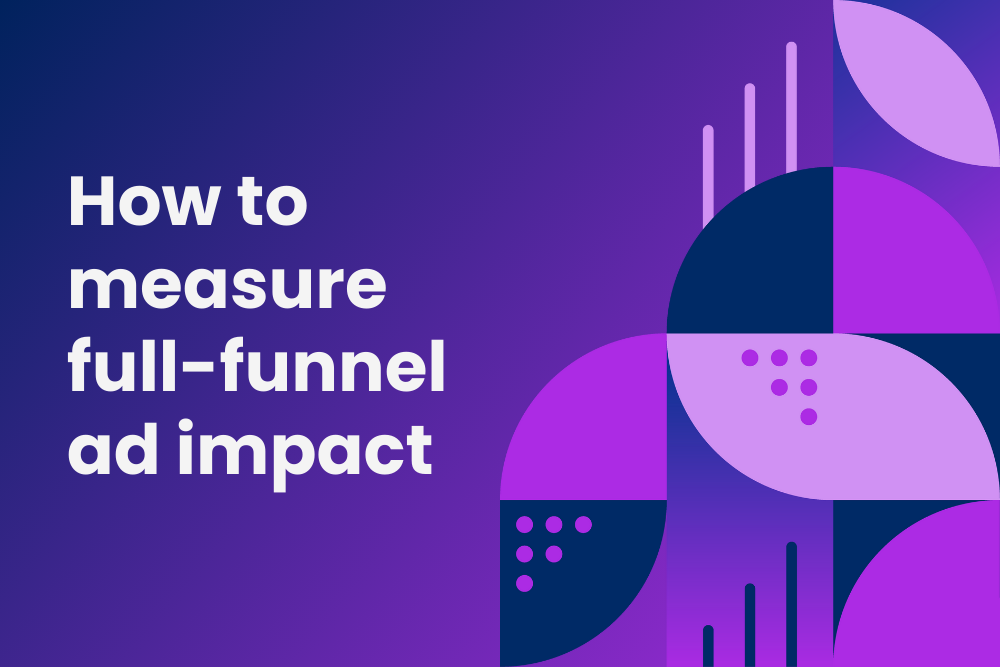How consumer consent and a single-source methodology for brand lift and outcomes lift can show advertising roi
Have you ever driven to an unfamiliar destination while guided by your GPS when suddenly it loses its signal and fails, leaving you in a panic and wondering if you’re still heading in the right direction? Ad effectiveness measurement can often be like that. One minute you have a clear path and the next, it’s muddled.
Whether it’s deprecating cookies, a mish-mash of methodologies across siloed platforms, a lack of understanding about your advertising ROI, or not knowing exactly how your campaign stands up against industry norms, you need confidence in your measurement. You need to know that your campaigns are delivering results, that your metrics are accurate, and how your efforts are stacking up against the competition.
To get a clear picture, work with your customers instead of around them…
Media today is fragmented and complex, and no one seems to agree on how best to measure advertising across the entire landscape. Most marketers simply live with partial and obfuscated views of how their ads perform.
What if brands, agencies, and publishers had unified visibility into full-funnel campaign lift across all channels – digital, social, TV, audio, out-of-home, and print.? It is possible today, but not through cookies and other disappearing and problematic identifiers like IP addresses. Instead, you can measure brand lift and outcomes lift through a broad, opted-in consumer audience with a robust methodology that breaks down silos.
→ Download Now: Social Media Advertising Effectiveness Benchmarks
First: Embrace a consented approach to measuring brand and outcomes impact
By working with a large single-source audience that opts in to share about their customer experiences (including their experiences with your advertising), you’ll gain a comprehensive and objective view of key brand and performance KPIs. With brand lift, this includes unaided and aided brand awareness; advertising awareness; message association; and brand perceptions such as favorability, familiarity, consideration, and purchase intent. With Outcomes Lift, you’ll get key behavior metrics that illuminate the actions people take after ad exposure: ; search, site visitation, shopping activity,. Because it’s an opted-in, person-level approach, there’s no complicated math and no guesswork to connect tried-and-true brand-life metrics with verified behaviors.
→ Download Now: Future-Proofing Brand Lift
Second: Demand a robust methodology
The cookie is going away, maybe not completely and by tomorrow, but it is already unreliable today. Truthfully, it was never the perfect technology to get the best insights about consumer behaviors. Now is the time for marketers to demand a more rigorous and consumer-friendly methodology.
Ensure real, individual respondents
When measuring advertising effectiveness using surveys or passive behavioral data , it’s crucial that your partner has done the work to verify the authenticity of their audience. Bots and fraudulent participants can make measurement tricky and unreliable, especially if your selected vendor doesn’t have a direct relationship with the people in their audience. Ensure your partnere directly manages and holds high standards for data quality.
Pro tip: Source your brand lift survey takers from one audience instead of many. Look for a partner that has direct audience relationships, supplemented with a robust anti-fraud program. With a singular partner that has direct relationships with verified audience members, you can prioritize best-in-class participant quality checks like biometrics and an always-on, passive fraud screening to catch unusual behavior. You make vital business decisions based on your ad measurement, so you need the confidence in the underlying data.
Develop triple-match control groups
To truly know if your campaign moved the needle, you need to compare an exposed groups to a control group. Many brand lift measurement providers match on only two criteria: demographics and visits to websites where the ads appear. But a big piece of the puzzle is missing from this: prior brand propensity.
Brand predisposition is the strongest differentiator between those converting and not converting, yet traditional brand lift studies pay little to no attention to it. By matching on demographics, online activity (including site visitation beyond sites where ads are placed), and brand propensity – you can trust that results are accurate and actionable.
Measure cross-platform exposure
To measure exposure across digital platforms, connect directly with engaged people who have opted in to having their purchase journey behaviors passively. Consumer expectations and expanding privacy protections make it crucial to be transparent with people about how any data they may choose to share is collected and used.
Myth: people do not want toallow brands to collect their information for marketing purposes. Truth: While consumers expect to have choice and control over what information they share, many will opt in to participate because they want the benefits of personalization and to have an influence onthe brands they love. With an opted-in consumer audience, you can measure their online consumer activities across relevant sites and platforms — such as social media, mobile apps, shopping sites, and more.
This consented approach also enables consistent data collection across platforms, enabling comparability across campaign outcome metrics.
Get connected, full-funnel measurement
Traditional attribution approaches, like MTA (Multi-Touch Attribution) and conversion-based measurement, are often rife with missing data that can lead to incomplete insights. Tags and cookies will not fully capture ad impact on user search, review sites, or off-site sales. For example, click-throughs to a brand’s website might measure less than 10% of the total ad impact that a brand may create through a campaign.
The rise of retail media demands that marketers take new measurement approaches. Like social media before it, understanding the conversion of exposed consumers on siloed shopping platforms is challenging. Online retailers typically do not share data that easily connects with your own customer data. Again, this gets down to ensuring consumers’ privacy, but this lack of visibility means you only get a fraction of the information you need to understand campaign effectiveness holistically.
For a complete picture of ad impact — improved brand love, search behaviors, downstream shopping activity, and more — combine brand lift survey data with passively collected behavioral data from opted-in consumers.
Your marketing GPS: cross-platform brand and outcomes lift
Single-source, cross-platform brand and outcomes measurement result in a better understanding of campaign effectiveness, despite deprecating online identifiers. Appropriating Leonardo Da Vinci, Steve Jobs famously said: “Simplicity is the ultimate sophistication.” It applies perfectly to the evolving advertising measurement landscape. There are many complicated pathways to building insights about ad campaign effectiveness, but only one way to see the full picture: work with your customers instead of around them.
Ready to reshape your strategy? Contact DISQO and let's embark on this journey, with confidence, together!




